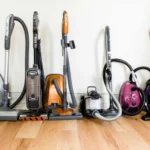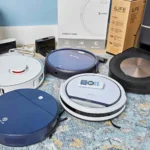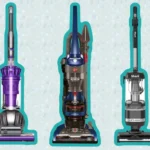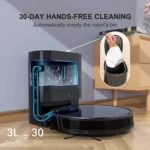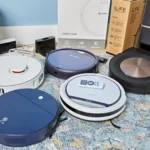Are you on the hunt for a high-performing canister vacuum cleaner, but overwhelmed by the vast array of options available on the market? One key factor to consider is whether to opt for a bagged or bagless model. Bagged canister vacuum cleaners have been around for decades and are known for their superior ability to contain dust and debris, making them a great choice for allergy sufferers and those who want a cleaner emptying process. On the other hand, newer bagless canister vacuums offer convenience and efficient cleaning of fine particles, without the need for replacement bags. But which type is right for your home and lifestyle? In this article, we’ll explore the pros and cons of each type and provide guidance on what factors to consider before making a purchase.
Advantages of Using a Bagged Canister Vacuum Cleaner
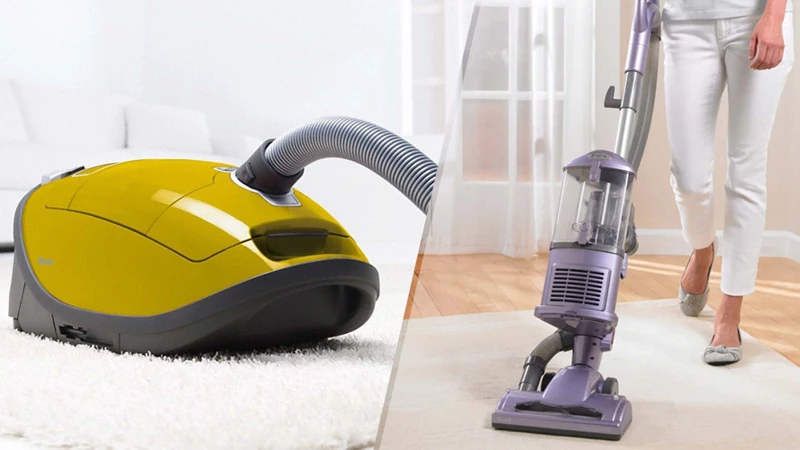
When it comes to cleaning your home, choosing between a bagged or bagless canister vacuum cleaner can be a difficult decision. While both styles have their benefits, there are some unique advantages to using a bagged canister vacuum. Not only can they save you money in the long run, but they are also better for allergy sufferers and help to contain dust and debris. In this section, we’ll explore these advantages in more detail and help you determine if a bagged canister vacuum is right for you. For more information on how canister vacuum cleaners work, check out our guide here.
Long-Term Savings
Bagged canister vacuums have long-term cost savings over their bagless counterparts, making them a wise investment for many households. While the initial cost of a bagged vacuum may be slightly higher, the cost-saving benefits of using a bagged vacuum over time cannot be ignored.
Here are the main reasons why bagged canister vacuum cleaners are more cost-effective in the long run:
| Reasons | Explanation |
|---|---|
| Longer Lifespan | Bagged canister vacuums usually have longer lifespan than their bagless counterparts. As they use bags to capture dust and debris, it reduces the wear and tear on the vacuum’s motor and other mechanical components, thus prolonging their lifespan. |
| Lower Maintenance | Bagged canister vacuums require less maintenance than bagless ones. As the bags are replaced regularly, there is no need for cleaning the filters and other parts on a regular basis. This saves both time and money on repairs and replacements. |
| Cost of Replacement Parts | The cost of replacement parts for bagged canister vacuums are usually lower than bagless ones. Because bagged vacuums contain fewer mechanical components, it is less likely to have costly repairs or require expensive parts replaced. |
Choosing a bagged canister vacuum over a bagless one can save you money in the long run. With their longer lifespan and lower maintenance requirements, the cost-effectiveness of bagged vacuums is hard to ignore.
If you want to read more about choosing the right canister vacuum for your home, check out our Canister Vacuum Buying Factors guide.
Less Messy to Empty
When it comes to cleaning out a vacuum cleaner, messiness is perhaps the most common complaint. However, with a bagged canister vacuum cleaner, the process of emptying the machine is much less messy. Unlike bagless models, bagged vacuums collect all dirt and debris in a disposable bag that can be easily removed and thrown away.
To further understand the convenience of a bagged canister vacuum cleaner, let’s take a closer look at the process of emptying a bagged vacuum compared to a bagless vacuum. The table below highlights some of the key differences:
| Bagged Canister Vacuum | Bagless Canister Vacuum |
|---|---|
| Disposable bag collects all dust, debris, and allergens. | Dirt and debris must be manually removed from the canister, which can cause dust and allergens to become airborne. |
| Removable bag can be easily thrown away without any contact. | Canister must be emptied manually, which can result in contact with dirt, dust, and debris. |
| No need to touch or come into contact with any of the collected dirt and debris. | May require shaking or tapping the canister to release all of the dust and debris, which can dirty the surrounding area. |
As you can see, a bagged canister vacuum cleaner is a much cleaner and more convenient option compared to a bagless model. With a bagged canister vacuum cleaner, there is no need to shake or tap the canister to release dirt and debris, meaning there is no risk of it spilling out onto the floor or getting back into the air. Plus, since the bag is disposable, you can simply throw it away, rather than having to clean out the canister every time you use the vacuum.
If you’re looking for more information on which type of vacuum to choose, check out our article on bagged vs. bagless upright vacuums or our canister vacuum chooser tool.
Better for Allergy Sufferers
Many individuals suffer from allergies and need to be careful when choosing a vacuum cleaner. Bagged canister vacuum cleaners are a better option for allergy sufferers for several reasons.
1. Traps Dust and Debris: Bagged canister vacuum cleaners trap the dust and debris inside the bag, preventing it from escaping back into the air. This feature is especially beneficial for allergy sufferers who want to minimize their exposure to dust and other allergens.
2. Uses HEPA Filters: Many bagged canister vacuum cleaners use high-efficiency particulate air (HEPA) filters. These filters capture tiny particles that can trigger allergies, such as pet dander, dust mites, and pollen. HEPA filters can remove up to 99.97% of particles that are 0.3 microns or larger in size.
3. Prevents Cross-Contamination: Bagged canister vacuum cleaners prevent cross-contamination of dust and debris from one room to another. This is because the bags are easily disposable, and this reduces the chances of coming into contact with the allergens.
4. Quieter: Bagged canister vacuum cleaners are generally quieter than their bagless counterparts, making them a great option for those who need to vacuum during the day without disrupting others.
5. Lower Emissions: Bagged canister vacuum cleaners emit fewer pollutants into the air than bagless models. This is due to the fact that the bag traps the dust and allergens rather than releasing them back into the atmosphere.
Bagged canister vacuum cleaners are a better option for allergy sufferers. They trap the dust and debris, use HEPA filters to capture allergens, prevent cross-contamination, emit fewer pollutants into the air, and are generally quieter. If you’re an allergy sufferer, it is important to consider these benefits before purchasing your next vacuum cleaner.
For more helpful tips on canister vacuums, check out our top 5 reasons to choose a canister vacuum cleaner and our guide to HEPA filters in canister vacuums.
Keeps Dust and Debris Contained
One of the main advantages of using a bagged canister vacuum cleaner is that it keeps dust and debris contained within the bag. When vacuuming with a bagged canister vacuum cleaner, dirt and debris are sucked into the bag and trapped inside, instead of being scattered back into the air. This ensures that the air inside your home remains clean and free of pollutants.
Vacuuming with a bagged canister vacuum cleaner is especially beneficial for those who suffer from allergies or respiratory issues. The bag acts as a filter, capturing even the smallest dust particles and preventing them from circulating back into the air. This is particularly important for people who are sensitive to dust mites, pollen, and other allergens that can exacerbate their symptoms.
Using a bagged canister vacuum cleaner also makes it easier to dispose of the collected dirt and debris. Instead of having to handle loose dirt and dust, you can simply remove the bag and throw it away. This method is much less messy than emptying and cleaning a bagless canister vacuum.
Using a bagged canister vacuum cleaner can be quieter than using a bagless one, as the bag absorbs some of the noise of the motor. This makes it a better choice for those who live in apartments or have young children who are easily disturbed by loud noises.
However, one of the main disadvantages of using a bagged canister vacuum cleaner is that it requires frequent replacement of bags. When the bag is full, it should be removed and replaced with a new one to maintain the vacuum’s efficiency. This can become costly over time, especially if you vacuum frequently.
If you prioritize long-term savings, ease of use, and maintaining clean air quality in your home, a bagged canister vacuum cleaner may be the right choice for you. For more tips on canister vacuum maintenance or advice on cleaning hardwood floors or utilizing attachments effectively, check out our helpful resources on canister vacuum maintenance, canister vacuuming hardwood floors, and canister vacuum attachments.
Quieter
One of the advantages of using a bagged canister vacuum cleaner is that it is typically quieter than a bagless model. This is because the bag acts as a noise barrier, muffling the sound of the motor. In fact, bagged vacuums are sometimes referred to as “quiet vacuums” because of their lower noise levels.
To give you an idea of how much quieter a bagged canister vacuum can be, let’s take a look at some decibel levels. On average, a bagged vacuum produces around 70 decibels of sound, which is about as loud as a conversation at a normal volume. In contrast, a bagless vacuum can produce 80 decibels or more, which is closer in volume to a garbage disposal or blender.
Although noise levels may not seem like a big deal, they can be a significant factor for people who live in apartments or have young children or pets at home. A quieter vacuum cleaner means less disruption to daily life and less stress for everyone involved.
Of course, quieter operation isn’t the only consideration when choosing between a bagged and bagless vacuum cleaner. There are many other factors to weigh, such as cost, convenience, and cleaning performance. The table below summarizes some of the key pros and cons of each type of vacuum cleaner:
| Bagged Canister Vacuum Cleaner | Bagless Canister Vacuum Cleaner | |
|---|---|---|
| Advantages | Long-term savings Less messy to empty Better for allergy sufferers Keeps dust and debris contained Quieter |
Convenience No need for replacement bags Efficient at cleaning fine dust and debris |
| Disadvantages | Requires frequent replacement of bags Less efficient at cleaning certain types of dirt and debris |
Higher upfront cost Messy to empty May aggravate allergies Noisy |
Ultimately, the choice between a bagged and bagless canister vacuum cleaner comes down to personal preferences and specific cleaning needs. By considering factors like budget, allergies, and home size and layout, you can make an informed decision that will help you keep your home clean and tidy for years to come.
Disadvantages of Using a Bagged Canister Vacuum Cleaner
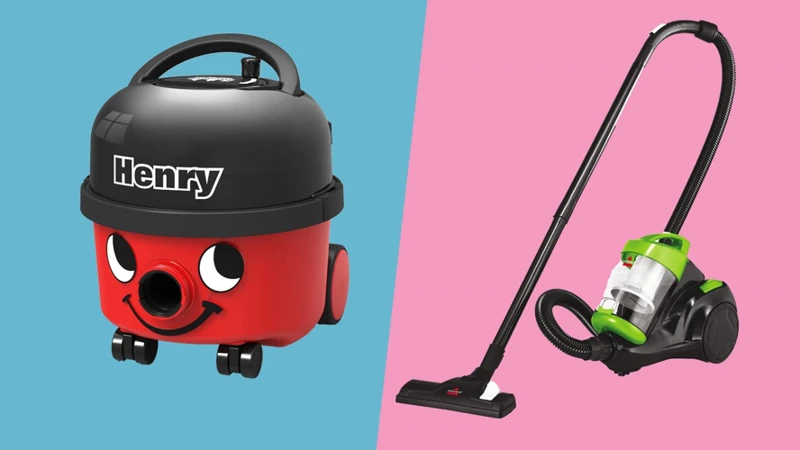
While bagged canister vacuum cleaners do come with their fair share of advantages, they are not without their drawbacks. It’s important to weigh the pros and cons before making a decision on which type of vacuum cleaner to purchase. Let’s take a closer look at the limitations of using a bagged canister vacuum cleaner.
Requires Frequent Replacement of Bags
One of the main downsides of using a bagged canister vacuum cleaner is that it requires frequent replacement of bags. This can add up to be a significant cost over time.
Bagged vacuum cleaners work by suctioning dirt and debris into a disposable bag that collects the mess. While this method keeps the majority of the dirt and dust contained and out of the air, it also means that you need to regularly change the bags to ensure optimal performance of your vacuum.
Depending on the frequency of use and the size of your home, you may need to replace the bag once a month or even more frequently. This means that you will need to purchase a steady supply of replacement bags, which can be an added expense.
To put this into perspective, the cost of replacement bags for a bagged vacuum cleaner can range from a few dollars to over $10 per bag, depending on the brand and the size. In addition to the cost, you also need to factor in the time and effort required to change the bags, which can be inconvenient for some people.
Despite the frequent need for bag replacement, bagged vacuum cleaners are still preferred by many due to their other benefits, such as lower noise levels, better air quality, and improved suction power. Ultimately, the decision to use a bagged vacuum cleaner will depend on personal preference and priorities.
Less Efficient at Cleaning Certain Types of Dirt and Debris
While bagged canister vacuum cleaners offer several advantages, they may not be the best option for tackling certain types of dirt and debris. Here are some specific examples of when a bagged canister vacuum may be less efficient:
- Larger debris: Bagged canister vacuums are not as effective at cleaning up larger debris, such as pebbles or nuts. These types of items can get stuck in the bag or damage the motor, reducing the efficiency of the vacuum.
- Pet hair: Bagged canister vacuums may struggle to pick up pet hair, especially for heavy shedders. Pet hair can clog the bag and reduce suction power, making it difficult to fully clean carpets and upholstery.
- Fine dust: While bagged canister vacuums are excellent at trapping allergens and keeping them contained, they may not be as effective at picking up fine dust particles. This is because dust can clog the pores of the bag, making it less efficient over time.
In these situations, a bagless canister vacuum may be a better choice since they are designed to handle a wider variety of debris. However, there are other factors to consider when choosing between a bagged and bagless vacuum cleaner, such as budget, allergies, and the size of the home.
Advantages of Using a Bagless Canister Vacuum Cleaner
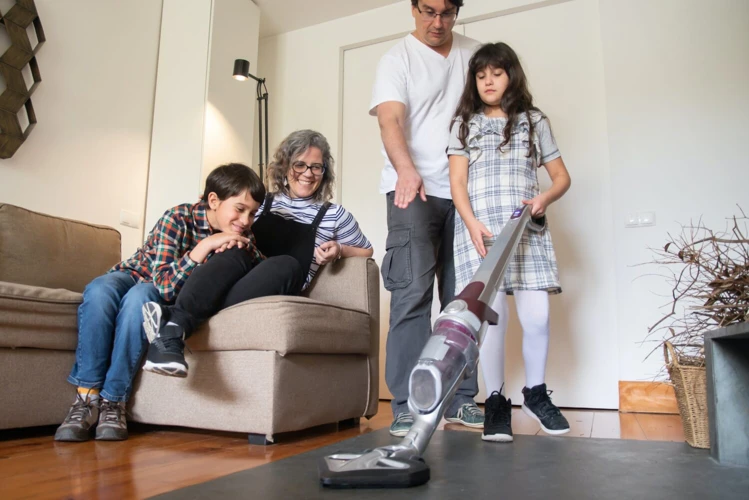
When it comes to choosing the right vacuum cleaner, bagless canister models have been gaining popularity in recent years. They offer several advantages that suit the needs of many homeowners. With no bags to replace and efficient cleaning power, bagless canister vacuums offer a convenient cleaning solution. Additionally, they are effective at capturing fine dust and debris, making them a great choice for those in need of a deep clean. Let’s explore the advantages of a bagless canister vacuum cleaner in more detail.
Convenience
One of the main advantages of using a bagless canister vacuum cleaner is the convenience it offers. With a bagless canister vacuum cleaner, you don’t have to worry about replacing the bag every time it fills up, which can be a hassle and an added expense. Instead, you can simply empty the dustbin once it reaches its capacity.
This can save you time and effort, as well as the frustration of having to stop in the middle of your cleaning to replace the bag. Additionally, you’ll never have to worry about running out of bags or forgetting to buy them, as you would with a bagged vacuum cleaner.
However, it’s important to note that while bagless canister vacuum cleaners may be more convenient in terms of bag replacement, they can be messier to empty. The dustbin can be full of fine dust particles that can escape into the air when emptied, potentially aggravating allergies or causing breathing problems.
Bagless canister vacuum cleaners tend to be noisier than their bagged counterparts, which may be an issue for those who prioritize a quiet cleaning experience.
Convenience is a significant benefit to using a bagless canister vacuum cleaner, but it’s important to consider other factors such as cost, allergy considerations, and home type before making a final decision.
No Need for Replacement Bags
One of the major advantages of using a bagless canister vacuum cleaner is that there is no need for replacement bags. Instead, dust and debris are collected in a removable canister that can be emptied and reused. This can be a big money saver in the long run since you won’t have to continuously purchase new bags.
However, it’s important to note that there are still costs associated with maintaining a bagless canister vacuum cleaner. For example, you will need to clean the canister frequently to prevent the buildup of dirt and debris. Additionally, some models may have filters that need to be replaced periodically to maintain optimal performance.
To help you better understand the costs associated with a bagless canister vacuum cleaner, we’ve put together a simple table highlighting some of the potential costs and benefits:
| Bagless Canister Vacuum Cleaner | Bagged Canister Vacuum Cleaner | |
|---|---|---|
| Upfront Cost | May be higher due to technology involved in collecting debris in a canister rather than in bags | May be lower due to fewer technological requirements |
| Replacement Costs | No need to purchase bags, but filters may need to be replaced | Will need to purchase replacement bags regularly |
| Maintenance Costs | May need to clean the canister and/or replace filters regularly | May not require as much maintenance |
Ultimately, the decision to use a bagged or bagless canister vacuum cleaner may come down to personal preference and lifestyle factors. For example, if you have a pet or allergies, you may prefer a bagged vacuum cleaner since it can better contain dust and debris. On the other hand, if you’re looking for convenience and long-term savings, a bagless vacuum cleaner may be the better option. Whatever you choose, be sure to consider all of the factors and do your research to find the right vacuum cleaner for your needs.
Efficient at Cleaning Fine Dust and Debris
Bagless canister vacuum cleaners have proven to be extremely efficient at cleaning fine dust and debris that bagged models sometimes struggle with. This is due to their advanced filtration systems that utilize air separators and multistage cyclonic technology to effectively remove even the smallest particles of dirt and debris.
One of the major advantages of a bagless canister vacuum cleaner when it comes to cleaning fine dust and debris is that it tends to have a more powerful motor than a bagged model. This increased power allows the bagless vacuum to pick up dirt and debris much more effectively, which is particularly important when dealing with fine particles like dust.
Bagless canister vacuums typically have a larger dustbin than their bagged counterparts, which means they can hold more dirt and debris before needing to be emptied. This is particularly useful when cleaning large areas or dealing with stubborn dirt and debris that requires multiple passes.
To further illustrate the efficiency of bagless canister vacuum cleaners when it comes to cleaning fine dust and debris, consider the following table:
| Vacuum Cleaner Type | Efficiency at Cleaning Fine Dust and Debris | Noise Level | Messiness of Emptying |
|---|---|---|---|
| Bagged | Limited | Relatively Quiet | Less Messy |
| Bagless | Highly Efficient | Noisier | More Messy |
As you can see from the table, bagless canister vacuum cleaners are far more efficient at cleaning fine dust and debris than bagged models. However, they tend to be noisier and messier to empty. Ultimately, it is up to the individual to weigh the pros and cons of each and decide which type of vacuum cleaner is best suited to their needs.
Disadvantages of Using a Bagless Canister Vacuum Cleaner
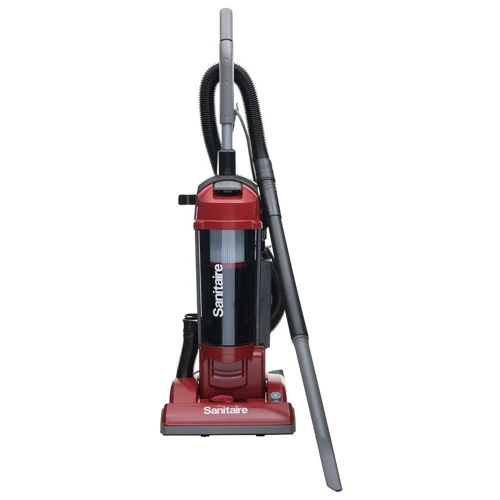
While bagless canister vacuum cleaners have their advantages, they also come with some drawbacks that shouldn’t be ignored. It’s important to understand the limitations of these machines before making a decision, as the cons might outweigh the pros for some households. Let’s take a closer look at the downsides of using a bagless canister vacuum cleaner.
Higher Upfront Cost
When it comes to the cost of a bagless canister vacuum cleaner, the upfront cost can be higher than its bagged counterpart. This is because bagless models often use specialized technology such as cyclonic suction and advanced filtration systems to effectively separate dirt and debris from the air. While this technology is beneficial in terms of cleaning efficiency, it can also contribute to a higher cost.
To illustrate this point, let’s compare two canister vacuum cleaners with similar features, one bagged and one bagless. The bagged vacuum costs $150, while the bagless vacuum costs $250, a difference of $100. However, over time, the bagless vacuum cleaner can save you money since it does not require the ongoing purchase of replacement bags.
Table: Cost Comparison of Bagged and Bagless Canister Vacuum Cleaners
| Bagged Vacuum Cleaner | Bagless Vacuum Cleaner | |
|---|---|---|
| Upfront Cost | $150 | $250 |
| Cost of Replacement Bags | $20 per year | N/A |
| Total Cost in 5 Years | $250 ($150 upfront + $100 in bags) | $250 ($250 upfront + $0 in bags) |
As shown in the table, while the bagless vacuum cleaner may have a higher upfront cost, it ultimately saves money over time since there is no need for replacement bags. Additionally, some bagless models offer washable filters, which can be reused instead of being replaced, further reducing the ongoing cost of maintenance.
While the higher upfront cost of a bagless canister vacuum cleaner may be a concern, it’s important to consider the long-term savings potential as well as the benefits of more advanced filtration and cleaning technology. Ultimately, the decision of whether to opt for a bagged or bagless model will depend on the individual’s budget and cleaning needs.
Messy to Empty
One of the disadvantages of using a bagless canister vacuum cleaner is the messy process of emptying the canister. When the canister is full, it needs to be emptied, which can be a messy and dusty process. The debris collected by the vacuum cleaner can start to fly all over the place, causing a considerable degree of perplexity.
Here are some things to consider when using a bagless canister vacuum cleaner:
- Clean-up Process: Emptying the canister requires removing it from the vacuum cleaner, opening it, and dumping the contents into the trash bin. During this process, dust, dirt, and debris can fly everywhere, creating a considerable mess. Care should be taken when dumping the contents so as not to create an even greater mess.
- Dust and Allergies: When emptying the canister, there is a risk of dust and debris being released into the air. This can be especially problematic for those with allergies or respiratory issues. The dust and debris can aggravate these conditions, causing discomfort and distress.
- Regular Cleaning: To prevent the canister from becoming too messy, it’s best to clean it regularly. This can be done by wiping it down with a damp cloth or rinsing it out with water (if it’s a washable canister). However, it’s essential to allow the canister to dry completely before using it again to avoid damaging the vacuum cleaner.
While a bagless canister vacuum cleaner can be more convenient in the long run since there’s no need for replacement bags, it’s essential to consider the messiness of the process. Clean-up can take up unnecessary time and effort, and for some people with allergies, it may not be worth the risk. Thus, when choosing between a bagged and bagless canister vacuum cleaner, it’s crucial to weigh the advantages and disadvantages carefully.
May Aggravate Allergies
One of the potential drawbacks of using a bagless canister vacuum cleaner is that it may aggravate allergies. This is due to the fact that bagless models tend to release more dust and allergens back into the air during the emptying process. When you empty the dustbin, you expose yourself to all the dirt, dust, and allergens that have accumulated inside, which can trigger sneezing, coughing, and other allergy symptoms.
To further compound the issue, many bagless vacuums don’t come with built-in filters or require the replacement of filters on a more regular basis as compared to bagged vacuums. This can also contribute to the release of allergens and dust back into the air.
For people with allergies or asthma, this could be particularly problematic. Inhaling irritants and allergens can worsen their symptoms and lead to respiratory problems. Repeated exposure to airborne allergens can also cause allergy sensitization and worsen allergy symptoms over time, making it essential to choose a vacuum cleaner that is less likely to exacerbate allergy symptoms.
That being said, it is important to note that some bagless vacuum cleaners come with advanced filtration systems that efficiently capture and retain allergens and dust particles. It’s essential to consider the filter quality and design when selecting a bagless vacuum cleaner to make sure it aligns with your specific requirements.
Here are a few additional tips for reducing the risk of exposure to allergens when using a bagless canister vacuum cleaner:
- Empty the container outside if possible to avoid dust and allergens settling inside your home
- Wear a dust mask during the emptying process to reduce the risk of inhaling dust and allergens
- Consider purchasing a bagless canister vacuum cleaner with a HEPA filter for optimum filtration
By taking these precautions and selecting a vacuum cleaner that suits your needs, you’ll be able to keep your home clean without putting your health at risk.
Noisy
One of the major disadvantages of using a bagless canister vacuum cleaner is the noise that it produces. The design of bagless vacuums often results in a louder sound, which can be bothersome for those who are sensitive to loud noises or if you’re in a small living space. The noise comes from the air moving through the vacuum’s motor and filters, which can be amplified in the plastic container that holds the dirt and debris.
Comparison of Noise Levels: Bagged vs. Bagless
To put this into perspective, let’s take a look at some noise level comparisons between bagged and bagless canister vacuums:
| Bagged Canister Vacuum Cleaner | Bagless Canister Vacuum Cleaner | |
|---|---|---|
| Decibel Level | Around 60 dB | Around 70 dB |
| Noise Level Comparison | Comparable to a normal conversation | Comparable to the noise of a hairdryer |
As the table shows, a bagless canister vacuum typically produces 10 decibels more noise than a bagged canister vacuum. This can be a significant difference, especially in small living spaces or for those with sensitivity to loud noises.
Noise Reduction Tips for Bagless Vacuum Cleaners
If you do choose to use a bagless canister vacuum cleaner despite the noise, there are a few things you can do to reduce the sound levels:
- Look for products that tout noise reduction features or technologies like insulated motors.
- Use the vacuum during the day or when you can tolerate the noise to avoid disrupting others.
- Consider the layout of your home and place the vacuum farther away from areas where noise will have a greater impact, like bedrooms and quiet reading areas.
- Wear earplugs or noise-canceling headphones if you are particularly sensitive to loud sounds.
Taking these steps can help reduce the noise impact of bagless canister vacuum cleaners, but it’s important to keep in mind that some level of noise will still be present. If you’re especially bothered by noise, a bagged canister vacuum cleaner may be a better option.
Factors to Consider When Choosing Between a Bagged and Bagless Canister Vacuum Cleaner
When it comes to choosing between a bagged and bagless canister vacuum cleaner, there are several factors to consider that will help you make the right decision. While both options have their pros and cons, the final choice ultimately comes down to personal preference and individual needs. In this section, we’ll delve into some of the most important factors that you should take into account before making a purchase. By weighing the benefits and drawbacks of each type of vacuum, you can ensure that you make a well-informed decision that fits your budget, lifestyle, and cleaning requirements.
Budget
When it comes to choosing a canister vacuum cleaner, budget is an important factor to consider. Both bagged and bagless models come in a range of prices to fit different budgets. However, it’s important to remember that more expensive doesn’t always mean better.
Bagged Vacuum Cleaners: Bagged canister vacuums typically have a lower upfront cost than bagless models. They also have lower ongoing costs because you have to replace bags less frequently than the filters in bagless cleaners. Replacement bags typically cost between $1 and $5 each, and most need to be replaced every 1-3 months, depending on how often you vacuum.
Bagless Vacuum Cleaners: Bagless canister vacuums usually have a higher upfront cost compared to their bagged counterparts. However, they don’t require replacement bags, which can save you money in the long run. Instead, you’ll need to clean or replace the filters periodically, which can cost between $10 and $50.
| Upfront Cost | Ongoing Costs | |
|---|---|---|
| Bagged Vacuum Cleaners | Lower | Less frequent bag replacement, typically $1-$5 per bag |
| Bagless Vacuum Cleaners | Higher | No bag replacement, periodic filter cleaning/replacement, typically $10-$50 per filter |
Ultimately, the cost of a canister vacuum cleaner will depend on your budget and cleaning needs. If you have a smaller home or apartment and don’t need to vacuum as frequently, a bagged model with lower ongoing costs may be a better option. On the other hand, if you have a larger home or need to vacuum frequently, a bagless model may be worth the higher upfront cost in order to avoid the ongoing cost of buying replacement bags.
Allergies
If you or any members of your household suffer from allergies, choosing the right type of canister vacuum cleaner is especially important. Both bagged and bagless options can have an impact on air quality, so it’s important to weigh the pros and cons carefully. Here are some factors to consider when making your decision:
| Factors to Consider | Bagged Canister Vacuum Cleaner | Bagless Canister Vacuum Cleaner |
|---|---|---|
| Dust Containment | Keeps dust and debris contained in the bag, reducing the likelihood of allergens and irritants being reintroduced to the air. | May release more dust and allergens back into the air during the emptying process, which can aggravate allergies. |
| Cleaning Performance | Effective at removing allergens and dust from carpets and floors, which can reduce allergy symptoms. | May not be as effective at picking up certain types of debris that can contribute to allergy symptoms, such as pet hair and dander. |
| Long-Term Maintenance | Requires regular replacement of bags, but this can also reduce exposure to allergens and irritants, as the bags serve as a barrier. | Does not require bag replacements but filter replacements are necessary, which could add to long-term costs. |
Ultimately, the best choice for allergy sufferers will depend on individual needs and preferences. Those with severe allergies may want to opt for a bagged canister vacuum cleaner as it provides better dust containment and effective cleaning performance. However, those who value convenience and prefer not to worry about replacing bags may prefer a bagless option. Regardless of which option is chosen, it’s important to regularly maintain and clean the vacuum to ensure optimal performance and minimize allergen exposure.
Type of Home (Pet owners, large vs. small homes, etc.)
When choosing between a bagged or bagless canister vacuum cleaner, one important factor to consider is the type of home you have. Specifically, if you are a pet owner or have a large home, you may want to pay particular attention to certain features of each type of vacuum.
Pet Owners:
If you have pets in your home, then a bagged canister vacuum cleaner may be better for you. This is because bagged vacuums can trap more pet hair and dander, and keep them from getting back into the air as you empty the vacuum. Additionally, bagged vacuums have a greater capacity to hold pet hair without losing suction than their bagless counterparts.
On the other hand, bagless canister vacuums may be more efficient at cleaning up pet hair simply because you can see when the canister needs to be emptied. This allows you to prevent any build-up that could potentially clog the filter.
Large Homes:
If you have a larger home, then a bagless canister vacuum cleaner may be more practical. This is because bagless vacuums typically have a larger capacity than bagged vacuums, which means you can clean for longer periods without needing to stop and empty the canister or replace the bag. This can save you a significant amount of time and effort.
However, if you have a larger home and also suffer from allergies, then a bagged vacuum cleaner may be more beneficial, as they are typically better at containing dust and debris.
Small Homes:
For those with smaller homes, the choice between a bagged or bagless canister vacuum cleaner may come down to personal preference or budget. Bagged vacuums may be more cost-effective in the long run, as bags can be replaced less frequently. However, bagless vacuums may be more convenient and easier to maneuver in smaller spaces.
Ultimately, the type of home you have will play a significant role in deciding which type of canister vacuum cleaner you should buy. It’s important to consider your specific needs and preferences before making a decision.
Conclusion
In conclusion, when choosing between a bagged and bagless canister vacuum cleaner, there are multiple factors to consider to ensure that you make the right decision for your needs. If you prioritize long-term savings, reducing mess during emptying, and have allergy sufferers in your household, a bagged canister vacuum cleaner may be the best choice for you. On the other hand, if you prioritize convenience, not having to purchase replacement bags, and efficient cleaning of fine dust and debris, a bagless canister vacuum cleaner may be the way to go.
It is important to weigh the advantages and disadvantages of each type of vacuum cleaner carefully. Keep in mind that a bagged canister vacuum cleaner will require frequent replacement of bags and may not be as efficient at cleaning certain types of dirt and debris. In contrast, a bagless canister vacuum cleaner may be noisier, more expensive upfront, messy to empty, and could possibly aggravate allergies.
Ultimately, when making the decision between a bagged and bagless canister vacuum cleaner, it is important to consider your budget, any allergies in your household, and the type of home you have, including pets and the size of the space you need to clean. By considering all of these factors and weighing the pros and cons of each type of vacuum cleaner, you can make an informed decision and choose the best option for your specific needs.
Frequently Asked Questions
What is a bagged canister vacuum cleaner?
A bagged canister vacuum cleaner is a type of vacuum cleaner that uses a disposable bag to trap dirt and debris. The bags need to be replaced when they are full.
What is a bagless canister vacuum cleaner?
A bagless canister vacuum cleaner is a type of vacuum cleaner that doesn’t use bags. Instead, it collects dirt and debris in a removable canister that can be emptied and cleaned.
Which is better, a bagged or bagless canister vacuum cleaner?
It depends on your personal preferences and needs. Each type of vacuum cleaner has its own set of advantages and disadvantages, which you should take into consideration when making your decision.
How often do bags need to be replaced in a bagged canister vacuum cleaner?
The frequency of bag replacement depends on how often you use your vacuum cleaner, how dirty your floors are, and the capacity of the bag. In general, bags need to be replaced when they are about 3/4 full.
Can you reuse bags in a bagged canister vacuum cleaner?
No, bags in bagged canister vacuum cleaners are designed to be disposable and should not be reused. Reusing bags can compromise their efficiency and result in poor suction and less effective cleaning.
Are bagged canister vacuum cleaners better for allergy sufferers?
Yes, bagged canister vacuum cleaners are better for allergy sufferers because the bags trap dust, dirt, and allergens, preventing them from getting back into the air during cleaning.
What types of debris are bagged canister vacuum cleaners less efficient at cleaning?
Bagged canister vacuum cleaners are less efficient at cleaning large debris, such as leaves or twigs, because the bags can get clogged quickly. However, they are great for cleaning fine dust and hair.
Do bagless canister vacuum cleaners make a lot of noise?
Bagless canister vacuum cleaners can produce more noise than bagged canister vacuum cleaners due to their powerful motors and the lack of sound-dampening material inside the canister.
Do bagless canister vacuum cleaners require frequent cleaning of filters?
Yes, bagless canister vacuum cleaners require frequent cleaning of filters to maintain optimal suction power. This process can be time-consuming and messy, especially if the filters are clogged with fine dust.
Which factors should I consider when choosing between a bagged and bagless canister vacuum cleaner?
You should consider your budget, allergies, and the type of home you have (e.g., pet-owners, large vs small homes). You should also consider how frequently you will need to clean your floors and whether you prefer a vacuum cleaner that is easy to clean or one that is more affordable in the long run.



